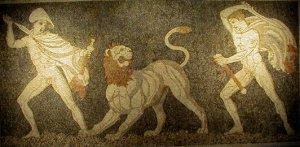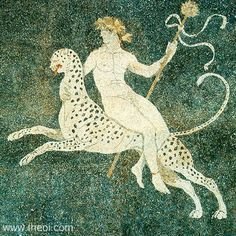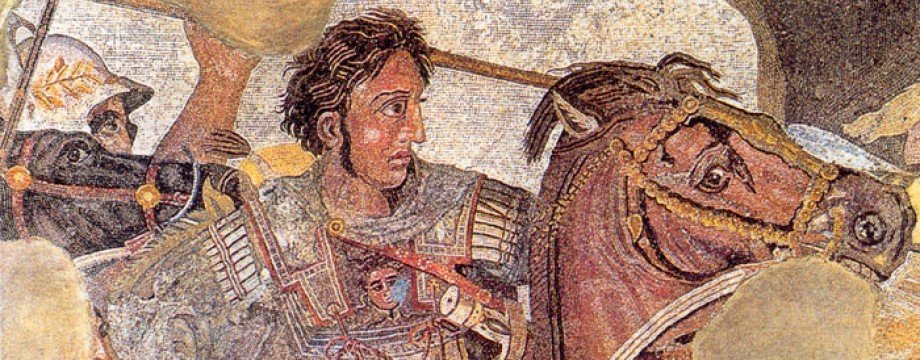This post is me unpacking my thoughts regarding the Pella Lion Hunt mosaic. Please forgive its length and, probably obvious, conclusion. The identity of the people in the mosaic is not something I had seriously considered before so was starting first base here

I have just started reading By the Spear, Ian Worthington’s account of the lives and deeds of Philip II and his son Alexander.
At the start of the book, Worthington talks about how Macedonian boys were taught to hunt from an early age. It was a way of teaching them how to fight against men when they grew up.
Hunting, however, was more than just a utilitarian exercise.
… it allowed time for the king and his nobles to interact socially, which affected their relations politically. These hunts were clearly dangerous, as a mosaic depicting a lion hunt from Pella attests.
The mosaic that Worthington is referring to here is, of course, the one you can see at the top of this post. He goes on,
Although the figures on the mosaic have been disputed, most likely we have Alexander to the animal’s left, trapped by its paw, and Craterus (who became one of Alexander’s generals) to its right, coming to his rescue… Both are wearing next to no protective clothing and are armed only with short swords - they thus had to get up close and personal with their deadly prey and rely on split-second instincts.
When I read the above passage, I was very taken by Worthington’s statement that Alexander was trapped by the lion. I had never noticed that detail before. And certainly, if you look at his expression, he does seem very alarmed. So, thank you to Ian Worthington for showing me something new in an image I thought had nothing new to say.
***
It was very unwise of me to think that the Pella Lion Hunt Mosaic had nothing new to say when it is such a mysterious image. Worthington identifies the man on the left with Alexander, and the man on the right with Craterus. The mosaic, however, makes no such identification on either account.
The man on the left wears a kausia (‘wide-brimmed felt hat’ as Worthington calls it) but while this was worn by Macedonian kings, it was not worn exclusively by them. In fact, up until Alexander became influenced by Persian customs and dress, his royal predecessors seem to have gone out of their way to be as much like their men as possible, including in what they wore.
Perhaps there is something in the cloak, spear or scabbard that the man on the left is holding that suggests Alexander, but if there is, I’m afraid I can’t see it. The same applies to the man on the right in respect of Craterus.
The Lion Hunt Mosaic was found in a Pella residence known as The House of Dionysos, named after another mosaic found there (see below). The house was a big one. It obviously belonged to an extremely wealthy individual. This video shows what kind of a place it was.
If you watch the video, you’ll see that it places the Lion Hunt Mosaic in the very centre of the building. Whoever lived here, the mosaic meant a lot to them, and they would have wanted as many people as possible to see the work.
So who did live in this residence? Well, I’m afraid I don’t know. But whether it was a royal property or belonged to a nobleman, here are some thoughts I have regarding the Lion Hunt Mosaic.
Firstly, whoever the two figures are, I think that the one on the right stands for the owner of the house, or at least the one who paid for the mosaic and probably had a residence there. He is the one coming to the rescue of the other man, after all; it would make sense for him to place himself in the starring role, so’s to speak.
Secondly, I have seen the creation of the mosaic dated to between 325-300 B.C. If the two men are not Alexander and whoever but are simply two hunters, whether real of fictional, then there is nothing more to say about it; it simply records a hunting trip of some description and was made in the late fourth century B.C.
If, however, the man on the left is Alexander then the identity of the man on the right becomes very intriguing.
Imagine walking into the House of Dionysos. Come, the owner says, Come and look at my new mosaic. You walk into the central room and there you see that he has had a mosaic installed in which ‘he’ is rescuing King Alexander. It is between 325 and 300 B.C. You know about the king’s amazing exploits in the east. If this man had no connection to Alexander then this mosaic would surely come across as a bit presumptuous. Actually, the mere fact that the man placed himself in a mosaic with Alexander would be laughable. And the fact that he showed himself rescuing the king would be ridiculous.
So, if the man on the left is Alexander, I think the man who paid for the mosaic knew him, and probably fought alongside him; not just as a junior officer much less a rank and file soldier but as a general, and maybe even directly helped the king if not saved his life on one or more occasions. This would have definitely entitled the man to put himself next to Alexander on the mosaic, and even to come to his rescue.
Ian Worthington identifies the man on the right with Craterus. As he says, though, the identification is disputed. I have also seen Hephaestion mentioned as the right hand figure. A couple of other names occur to me - Black Cleitus and Peucestas.
Black Cleitus and Peucestas were both high up in Alexander’s army and both saved his life (Cleitus at the Granicus in 334 and Peucestas at the Mallian town in 325). Cleitus died in 328. There is no reason he could not have ordered the making of the mosaic before then but I would question whether he would have wanted to, given how estranged he had become from Alexander due to the latter’s orientising ways. As for Peucestas, I think his focus was on the future, not the past. He could have ordered the mosaic to be made after 325 but I suspect he was too busy getting used to his Persian trousers.
In truth, there are probably any number of people who could have ordered the mosaic but let’s go back to Craterus and Hephaestion. Hephaestion was Alexander’s best friend and fought alongside him. He was a nobleman, to boot. He surely had the money and motive to have the mosaic made. But did he have the ego to show himself saving Alexander’s life? We know from Diodorus (XVIII.114) that Hephaestion was perfectly comfortable in his friendship with Alexander. I don’t think he would have felt the need to show how important he was to the king, even to the point of saving his life.
Craterus, however, is another matter. He loved Alexander more than any other man. But, as Alexander himself pointed out (D. XVIII.114; Plutarch Life of Alexander 46), Craterus loved Alexander the king whereas Hephaestion loved Alexander the man. This could only have angered and distressed Craterus as he would have known that to love the man rather than the office placed Hephaestion closer to Alexander’s heart than himself - a very painful position for a lover of any kind to be in. No wonder he and Hephaestion feuded. Therefore, I think Craterus commissioned the mosaic not just to show how close he was to Alexander but as a slight against Hephaestion and act of self-affirmation: I was important to Alexander, I WAS (and more than him, too)*.
Another reason I am going with Craterus as the man on the right is that according to Robin Waterfield in Dividing the Spoils,
Craterus marked the end of the Lamian War with a large monument at Delphi, sculpted by the best artists of the day, that showed him saving Alexander’s life during a hunt…
He did it at Delphi, I think he did it at Pella, too. It would not surprise me to learn one day that the building we call the House of Dionysos was Craterus’ family residence.

Dionysos riding on a panther; the mosaic from which the House of Dionysos takes its name (Source: Theoi via Pinterest)
* On this point, Hephaestion may have been comfortable in his friendship with Alexander but he could be a very proud man, and there is space within this to see him ordering the mosaic’s creation for similar reasons to Craterus. When I think about that, though, I go back to his letter to Olympias and it seems to me that however proud he was, he was not self-doubting

As much as I think it would be nice to have a mosaic like this depicting Alexander and Hephaestion together, I agree with your logic that this is most likely Craterus. As you said, I don’t think there was any need in Hephaestion to show his position in Alexander’s life. That was a given. But I can totally see Craterus wanting to showcase how important HE was to the king. Interesting post.
LikeLiked by 1 person
Thank you ~ MJM
LikeLike
Have you seen this? It is the front cover of Funeral Games. I never guessed it was Alexander on the left and Kraterus on the right. Did you know? Penina
LikeLike
I never considered that Alexander was trapped in the depiction. It is amazing how you can see a piece of art all your life and never consider the obvious. Now I can’t unsee it. The marker in Pella does not identify either of the figures and simply says, “The Lion Hunt.” Best to avoid controversy at the museum, I suppose.
LikeLike
The ancient reference to Krateros saving Alexander from a lion is the reason most scholars go with the identification in the mosaic as Krateros. These houses are all Hellenistic. Krateros outlived ATG (if not by much). Hephaistion didn’t.
LikeLike